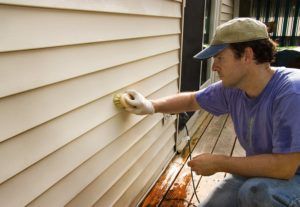Siding is often one of the first upgrades homeowners consider when they want to improve the look of their homes. Siding is also one of the most important upgrades for long-lasting protection against the elements.
From a 2020 base, siding demand in the US is projected to increase at an average rate of 1.4% annually through 2025.
The primary benefit of siding is its ability to protect your home from moisture and water damage. It also provides a layer of insulation that helps keep your house warmer in the winter and cooler during the summer months.
When it comes to siding, there are two main types: horizontal and vertical. Both are popular options for homeowners and have their strengths and weaknesses. This guide will help you decide which type of siding is right for your home.
What Is Horizontal Siding?
Horizontal siding is one of the most popular types of exterior coverings. This siding is designed to cover large sections of your home in long strips that run horizontally across the structure’s exterior walls.
Typically made from wood or vinyl panels, horizontal siding can hide unsightly features like air conditioners, gutters, and other protruding items on your home’s exterior walls by providing a seamless surface for them to rest against instead of letting them stick out into plain view like they would with standard brick or stucco exteriors.
The advantages of this type of siding include:
Aesthetics
Horizontal siding can be installed in a variety of patterns and styles, including plain and textured panels that mimic the look of brick or stone, or it can be painted with any color you choose.
This type of siding runs parallel to the ground, with each piece overlapping the next one by half an inch or more. It’s often made from wood, vinyl, or fiber cement (a blend of wood fiber and concrete).
Horizontal siding can be painted or stained and is easy to maintain because you can wash it down with water when it gets dirty. You can also get different colors of horizontal siding to match your home’s color scheme.
Durability
Horizontal siding is incredibly durable and can last decades with proper maintenance. It also holds up well against extreme weather conditions such as snow and rain because it’s installed away from the elements rather than directly exposed to them like vertical siding.
Cost
Horizontal materials tend to be less expensive than vertical materials because they require less labor to install and maintain over time. This type of siding is also more energy-efficient than vertical materials.
However, there are some premium options like wood shingles or brick that can cost more than their counterparts due to the high demand for these products compared with less expensive options like vinyl or aluminum panels.
It’s important to factor in these costs when comparing various styles of horizontal siding as well as their long-term performance to determine which option is right for you.

Only high-quality materials from trusted manufacturers when handling siding installation
What to Know About Vertical Siding
Vertical siding often adds style and architectural interest to a house while also helping to protect it from the elements like wind and rain. Vertical siding comes in many different styles and materials, including wood, brick, stone veneer, concrete block, and vinyl-covered steel panels.
Vertical siding is a more expensive option, but it’s gaining popularity as homeowners and designers look for ways to make their homes stand out from the crowd. Vertical siding can add a modern, sleek look to your home or it can help complete the historic feel that you’re going for.
Vertical siding is typically installed vertically along the length of the wall with its surface facing outward toward the street or yard area. It’s often used for exterior commercial buildings such as restaurants, hotels, or retail stores where customers can see it up close.
Choosing the Right Siding Is an Important Step in the Process
Vertical siding comes in many different materials and styles, but it’s usually made from wood or fiber cement. Vertical siding is typically used on corners or edges where two walls meet at an angle (such as a gable end).
It’s often found on commercial buildings but can also be used on residential homes if desired — especially if you want a unique look that stands out from the crowd.
Vertical siding provides more protection against the elements than horizontal siding, but it also requires extra maintenance to keep it looking good and functioning properly.
Always Consult With a Siding Professional First
Horizontal siding is most common and therefore most popular because it can be installed on any type of wall and comes in many different styles. Vertical siding has its own benefits as well, but it’s not as easy to find or install.
If you are looking for a new style or need something that will last longer than horizontal siding, vertical might be the best choice for you. If you want to learn more about the benefits of each type of siding, contact a company that specializes in windows and siding installation.


